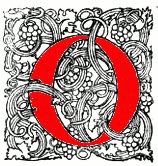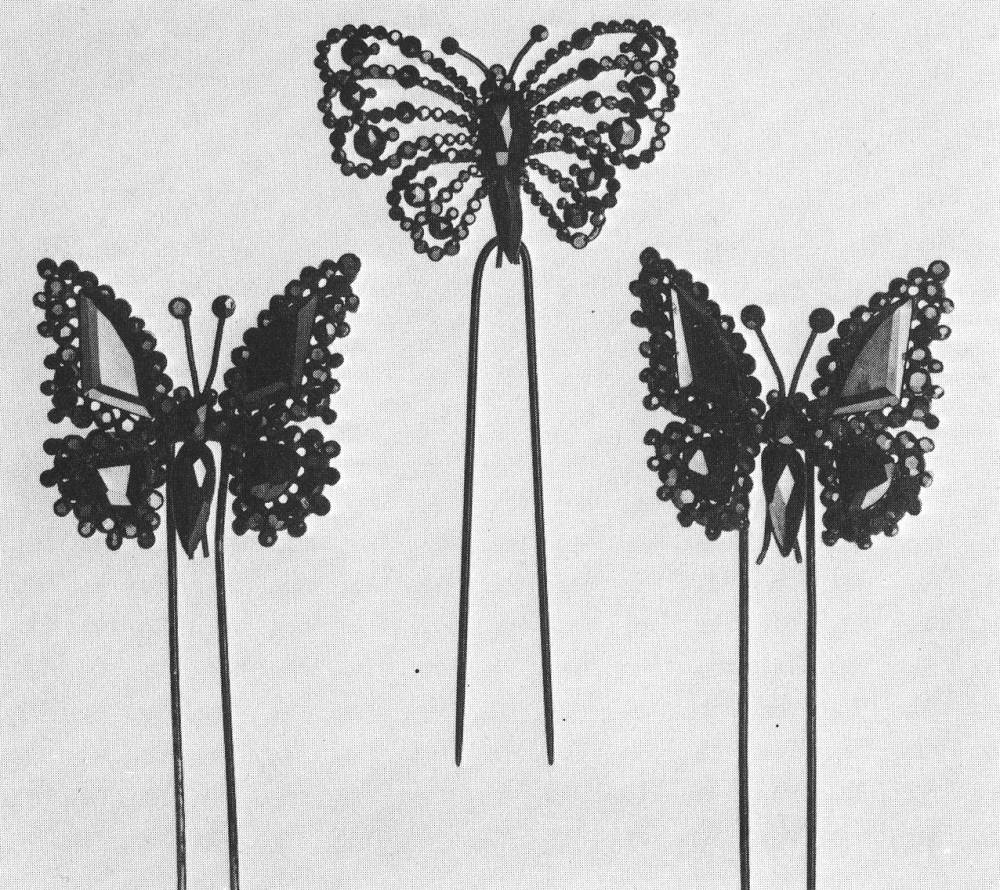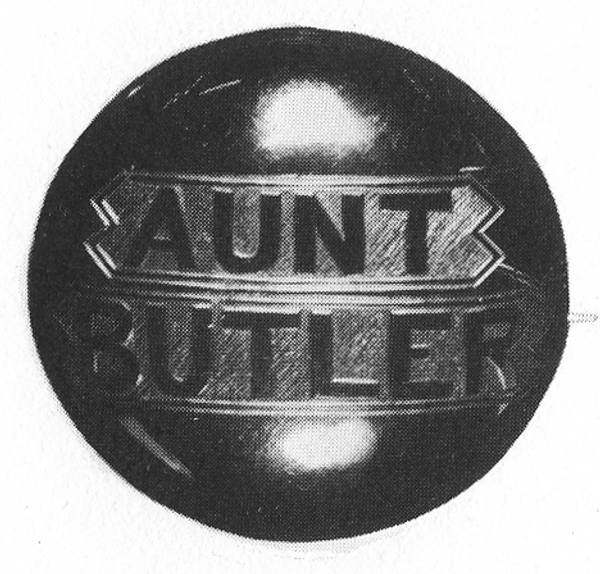
f all the Victorian leaders of fashion the Queen was one of the least influential. Her preferences in the matter of dress were not widely adopted except in the case of one or two rather down-to-earth articles such as the eminently practical 'Balmoral' boots, though her love of this Scottish retreat did have the effect of making both tartan and Scottish jewellery popular, even in France. Her taste for all kinds or sentimental jewellery was imitated by her contemporaries of all classes.

Plate 126. The 'Florence Nightingale' Brooch designed by Prince Albert and made by Messrs. Garrard. 1855. Florence Nightingale was less than grateful for the gift. Courtesy of the National Army Museum.
The brooch presented to Florence Nightingale in 1855 (Plate 126) by the Queen, which was designed by Prince Albert, expressed a number of complex sentiments. There is not a single stone of this brooch which has not got some special significance; the centre piece of the brooch is a St George's Cross in ruby coloured enamel on a white ground, meant to represent England; this is surrounded by a band of black enamel inscribed 'Blessed are the merciful', representing Charity; the Royal initials at the centre of the St George's Cross are surmounted by a crown from which gold rays spread out on to the white enamel at the back of the cross, representing the glory of England. The ribbon which ties the stems of the green enamel palms which frame the brooch is the pale blue colour of the ribbon of the Crimea medal, and the three diamond stars surmounting the whole represent the 'light of heaven shed upon the labours of Mercy, Peace and Charity, in connection with the glory of the Nation'. To have welded all these complex elements into a coherent whole was no mean feat, but the Prince was no mere dilettante amateur; even if some of his artistic achievements lack the spark of genius, his approach is unfailingly professional. Florence Nightingale's brooch may look more like the tedge of some unknown order than a frivolous decorative ornament but this is, in effect, what it is.
Queen Victoria's letter to Florence Nightingale which accompanied [243/244] the brooch leave no doubt as to her intention, that this gift should be regarded as an award:
Windsor Castle, November 1855 . . . therefore send you with this letter a brooch, the form and emblems of which commemorate your great and blessed work, and which I hope you will wear as a mark of the high approbation of your sovereign!'
Florence Nightingale was not so grateful as the Queen might have hoped her to be, medical supplies would have been more gladly received; her sister. Lady Verney, wrote urging her to wear this unwelcome gift, and she does seem to have done so on one occasion, a party given at the British Embassy in Scutari on Christmas Day, 1855. Lady Hornby, who was present at the Embassy wrote to her sister Mrs Vaillant, on January 5th, 1856, the following description of the most distinguished guest:
Her dress, as I have said, was black, made high to the throat, its only ornament being a large enamelled brooch, which looked to me like the colours of a regiment surmounted with a wreath or laurel, no doubt some graceful offering from our men.
Although this brooch looks so much like an order it is in the direct tradition of the commemorative jewellery so much beloved by the Victorians, who were prone to order apiece of jewellery to remind them of every possible occasion of significance, one of the oddest being the brooch designed to commemorate the night that Inverary Castle was burnt, October 12th, 1877. Lady Frances Balfour (daughter of the Duke of Argyll) wrote inNe Obliviscaris :
'My mother designed a Brooch to commemorate the night. A St Andrew's Cross on a silver shield, above the Cross rose enamelled flames. On the cross is written: "Inverary Castle, October 12, 1877", and underneath the words "Laus Deo". It was given to the many who were present, and who would "Never Forget".'
Into this same category comes the vast quantity of mourning jewellery which was produced during the nineteenth century; preserved out of sentiment or piety, and rarely made out of valuable enough material to make it worth breaking up, fashions in this particular branch of the jewellers' art can be studied without the smallest difficulty in any jewellers' shop in the country. Little [244/246] of the surviving work is of any startling originality of design but like so much of the uninspired jewellery of the period, is of splendidly solid construction.


Left: Plate 126. Mid-nineteenth century Mourning jewellery. Decorated with hairwork, half pearls and seed pearls and black enamel. Collection of the author. Right: Plate 125. Cross and necklace in hair-work and gold. Courtesy of the London Museum. Mid-nineteenth century. Hair-work of this period is extremely complex, as can be seen from some of the more ambitious examples shown in the Great Exhibition in 1851.
Court mourning in England called for the wearing of jet, a favourite material for mourning jewellery which, like hairwork, another material traditionally associated with mourning, was also fashionable in the sixties. The ladies of the French Court were permitted to wear onyx jewellery, and outside Court circles where observances of mourning etiquette were less strictly observed garnets were considered entirely suitable.


Left: Plate 128. Three Hair Ornaments in jet, mid-nineteenth century. The pair of butterflies are attached to the hair-pins on hinges, the central one is mounted on a small spring designed to make it tremble.Cross and necklace in hair-work and gold. Courtesy of the London Museum.
Great differences in style are apparent in mourning jewellery from one generation to the next The macabre jewels which were popular in the seventeenth century, with their skulls or complete skeletons minutely delineated in enamel which can still just be discerned under the scratched crystal which covers them, were replaced by the familiar neo-classic designs of the late eighteenth century containing all the paraphanalia of late Georgian memorial sculpture, broken columns, urns, weeping willows and weeping women; and these were in their turn replaced by the turgid sentimentality of Victorian mourning jewellery. After the death of the Prince Consort, the Queen's example gave a considerable impetus to trade which supplied the already extensive panoply of grief. Mourning etiquette was religiously observed by all classes of society and the demand for mourning jewellery was so great that it had to be mass-produced, which explains the somewhat 'all- purpose' look of some of the less expensive jewellery. Apart from jet which was used for mourning jewellery of all kinds, the Victorians had a great preference for hair-work, a large quantity of which was produced by young ladies following the instructions in a monthly magazine or one of the booklets which were available , like The Jewellers Book of Patterns in Hairwork by William Halford and Charles Young, published in London in 1864. Grace Darling was obliged to cut off almost all her hair to give to the many people who asked for it. It is possible that some of it found its way into one of these home-made jewels, and this would have considerable curiosity value, though not as great as that of thc locket containing Byron's hair which was recently sold in London.
Hair-work was by no means always for memorial jewellery, but also for the jewellery exchanged at the time of a betrothal or marriage. The album of Mr Whitford of Garrards (see p. 22) contains an envelope with a lock of Queen Alexandra's hair in h which was to be put into a bracelet at the time of her marriage in 1863. There is a confusing similarity between the mourning jewellery of this period and the many other types of sentimental jewellery which were popular. Miniatures were worn both for the [249/25] living and the dead, and were very popular though the high standard set by the eighteenth century practitioners of this delicate and demanding technique was rarely maintained. One type of miniature, the 'eye' miniature, which enjoyed great popularity in the eighteenth century, was virtually unknown in the mid-nineteenth century. Although Queen Victoria owned a miniature of the eye of her husband, it was considered old-fashioned to the point of eccentricity to own, or worse still, to wear one of these unlovely ornaments! Miss Tox, in Dombey and Son who obviously possessed both these characteristics in a marked degree, was in the habit of wearing one:
'Miss Tox's dress, though perfectly genteel and good, had a certain air of angularity and scantiness. She was accustomed [250/251] to wear odd weedy little flowers in her bonnets and caps . . . when full-dressed she wore round her neck the barrenest of lockets, representing a fishy old eye, with no approach to speculation in it. These, and other appearances of a similar nature, had served to propagate the opinion that Miss Tox was a lady of what is called a limited independence, which she turned to the best account.'
Many pieces of Victorian jewellery are adapted to accommodate miniatures, even photographs in the later years, locks of hair and other memorabilia; the locket which opens is the most common example of this type of jewel, but there are a number of bracelets which have central bosses which open. A considerable amount of space at the Great Exhibition of 1851 was devoted to jewellery of this kind, its chief claim to the attention of the public being an incredible ingenuity in its manufacture. Hansen and de Konig, of 440 Soho Bazaar — Artists, exhibited 'Work in human hair: Basket: flowers in natural size, in relievo. View of Kensal Green cemetery, in relievo.' Mr Forrer, of Hanover Street, exhibitor in the 1862 International Exhibition, showed hair brooches similar to the hair-work jewellery on Plate 125. The ingenuity and patience required to make the greater part of the jewellery produced during the nineteenth century is a constant source of amazement to modern critics though this aspect is rarely touched on by contemporary writers, even in this age of vastly increased mechanisation these demanding techniques were still taken for granted.


Left: Plate 127. Mourning brooch in onyx, gold and enamel inscribed 'N.M. Rothschild, Esq., Ob. 28th July 1836 Aet 58 H.S.C.'. Onyx mourning jewellery was also fashionable in France at this period. Right: Plate 129. Demi-parure in jet and gold, American c. 1870. Jet was fashionable for many years in the second half of the century in spite of its melancholy associations. Both objects courtesy of the London Museum.

Jet brooch with 'Aunt Butler' carved on it which commemorated one of Maria Edge-worth's half-sisters who died in the 1880's.
[250/251]9 March 2015